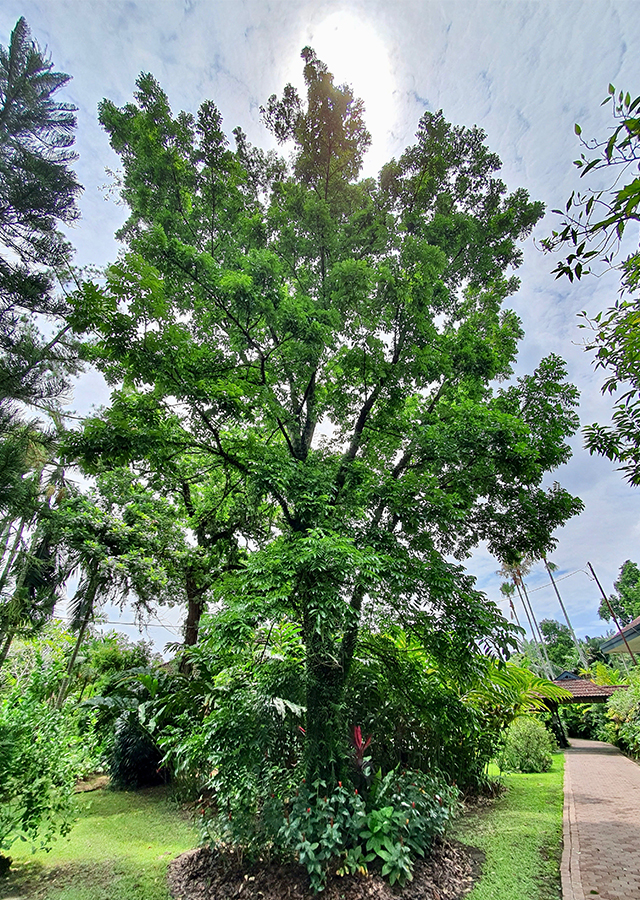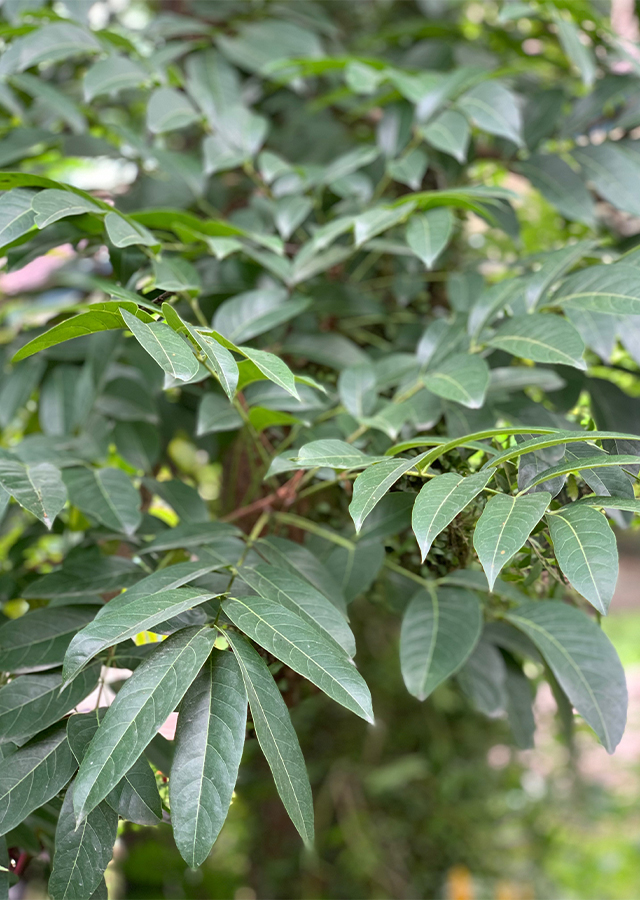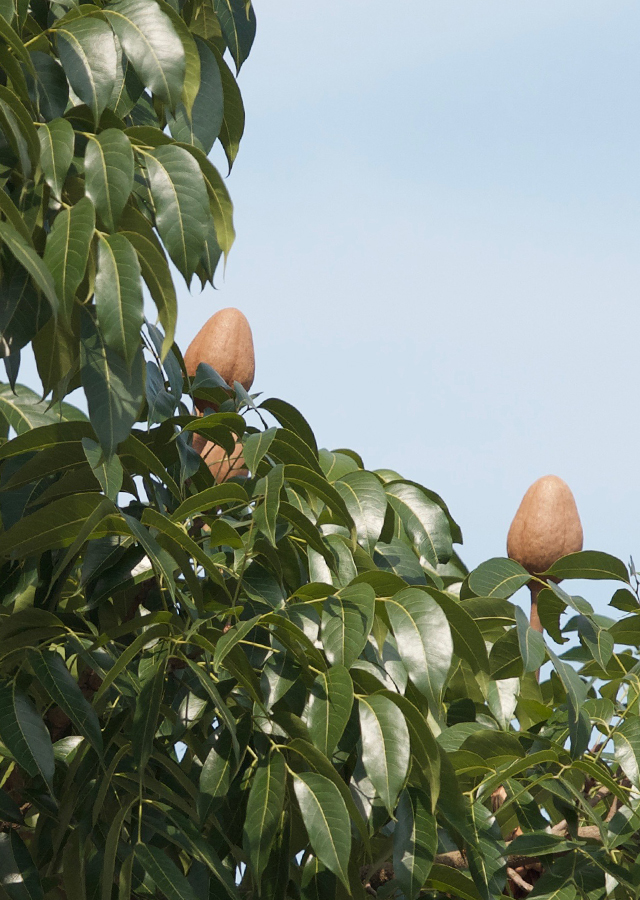Big-leaf mahogany
Swietenia macrophylla King
Meliaceae
Location in our garden
Orchard



Synonym
Swietenia belizensis Lundell
Swietenia candollei Pittier
Swietenia tessmannii Harms
Habitus
Trees. Tall tree with a height of up to (40-60 m), with diameter up to 150-(200) cm.
Part Used
Seeds
Bark
Growing Requirements
Full Sunshine
Need Shade
Habitat
Riverbanks
Forest
Overview
Native to the mainland of Central and South America, from Mexico to Peru, Boliviaand Brazil, which makes it the most widely distributed Swietenia species. The wood has been internationally traded for over 400 years. According to the IUCN Red List of threatened species 1998 data, Swietenia macrophylla is categorized as vulnerable.
Vernacular Names
Mahoni (Indonesia); Mahagni (Bangladesh); Big- or large-leaved mahogany (England); Acajou du Honduras (France); Echtes mahagoni (Germany); Mogano (Italy); Cheria mahogany (Malaysia); Mahonie (Netherland); Mogno (Portugal); Caoba, caoba de Honduras (Spain); Mahokkani-baiyani (Thailand); Gi[as]I ng[uwj]a (Vietnam).
Agroecology
Swietenia macrophylla may grow in a variety of soil types and environments. Tropical dry forest conditions with annual precipitation of 1000–2000 mm, a mean annual temperature of 24 °C, and a potential evapotranspiration ratio of 1–2 are reported to be ideal for this species' natural development.
Morphology
- Trunks - straight and cylindrical. Young trees have a narrow crown, whereas older trees have a broad, thick, and densely branching crown. Older trees' exterior bark is scaly, colored brownish-grey to reddish-brown, with red-brown to the pinkish-red inner bark. It has plank-like buttresses, with a height could more than 5 m.
- Leaves - normally paripinnate, sometimes be imparipinnate, and they are 12–45 cm long, with 3–6 pairs of lanceolate or ovate leaflets. The leaflets are asymmetrical, measuring 5–12 cm long and 2–5 cm wide, with a whole border and apex that is acute or acuminate.
- Flowers - unisexual, measuring 0.5–1.0 cm long and grown in huge, branching inflorescences with both male and female flowers.
- Fruits - 11.6–38.7 cm in length and 6.7–12.0 cm in diameter, colored light grey to brown capsular with 4-5 valves, shaped oblong or ovoid. Each fruit contains between 22 and 71 fully formed seeds.
- Seeds - samaroid, with a thick base, a length of 7–12 cm, and a width of 2–2.5 cm including the wing.
Cultivation
By seeds - no pre-treatment is required, butstored seed will germinate more rapidly if soaked in warm water for 12 hours prior to sowing. Seed can be sown in nursery beds or containers, covering the seed with 3 cm of soil.
Chemical Constituents
Tannins, 7 phragmalin limonoids, mahonin,tetranortriterpenoids, secomahoganin, 6-Desoxyswietenine, tetranortriterpenoid,alkaloids, terpenoids, anthraquinones, cardiacglycosides, saponins, volatile oils flavonoids, steroids, catechin, quercetin-3-O-β-D-glucopyranoside(isoquercitrin), 3-caffoeylquinic acid (neochlorogenic acid), quercetin-3-O-β-D-galactopyranoside (hyperoside), quercetin, kaempferol, swietemacrophyllanin, and epichatechin
Traditional Medicinal Uses
- The bark is astringent, bitter, and febrifuge.
- It is antimalarial and antihypertensive.
- The seeds have antibabesial and antidiarrhoeal activities
- The local folks of Malaysia believe that the seeds are capable of “curing”hypertension and diabetes. The seeds are usually consumed raw bychewing.
- A decoction of seeds is reported to treat malaria in Indonesia.
- An infusion is used to treat diarrhoea and fevers.
- Among the Amazonian Bolivian ethnic groups, the seeds are used to induce abortion by drinking a decoction of the seeds and to heal wounds and various ailments of the skin via external application of the mashed seeds.
- In Africa, bark decoction is used as febrifuge.
Part Used
Reference Sources
- Krisnawati, H., Kallio, M. and Kanninen, M. 2011 Swietenia macrophylla King: ecology, silviculture and productivity. CIFOR, Bogor, Indonesia.
- Azzahra, R.M.I. 2018. Analisis Morfofisiologis Mahoni (Swietenia macrophylla King.) Skripsi-Program Studi Kehutanan Fakultas Kehutanan Universitas Hasanuddin. Makassar.
- Falah, S., Suzuki, T., Katayama, T. 2008. Chemical constituents from Swietenia macrophylla bark and their antioxidant activity. Pak J Biol Sci. 11(16): 7-12. doi: 10.3923/pjbs.2008.2007.2012.
- Lemmens, R.H.M.J., Soerianegara, I. & Wong, W.C. (Editors), 1995. Plant Resources of South-East Asia No 5(2). Timber trees: Minor commercial timbers. Prosea Foundation, Bogor, Indonesia. 655 pp.
- Falah, S., Safithri, M., Katayama, T., Suzuki, T. 2010. Hypoglycemic Effect of Mahogany (Swietenia macrophylla King) Bark Extracts in Alloxan-induced Diabetic RatsWood Research Journal 1(2):89-94.


